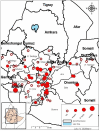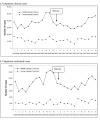Malaria prevalence and mosquito net coverage in Oromia and SNNPR regions of Ethiopia
- PMID: 18803880
- PMCID: PMC2556337
- DOI: 10.1186/1471-2458-8-321
Malaria prevalence and mosquito net coverage in Oromia and SNNPR regions of Ethiopia
Abstract
Background: Malaria transmission in Ethiopia is unstable and seasonal, with the majority of the country's population living in malaria-prone areas. Results from DHS 2005 indicate that the coverage of key malaria interventions was low. The government of Ethiopia has set the national goal of full population coverage with a mean of 2 long-lasting insecticidal nets (LLINs) per household through distribution of about 20 million LLIN by the end of 2007. The aim of this study was to generate baseline information on malaria parasite prevalence and coverage of key malaria control interventions in Oromia and SNNPR and to relate the prevalence survey findings to routine surveillance data just before further mass distribution of LLINs.
Methods: A 64 cluster malaria survey was conducted in January 2007 using a multi-stage cluster random sampling design. Using Malaria Indicator Survey Household Questionnaire modified for the local conditions as well as peripheral blood microscopy and rapid diagnostic tests, the survey assessed net ownership and use and malaria parasite prevalence in Oromia and SNNPR regions of Ethiopia. Routine surveillance data on malaria for the survey time period was obtained for comparison with prevalence survey results.
Results: Overall, 47.5% (95% confidence interval (CI) 33.5-61.9%) of households had at least one net, and 35.1% (95% CI 23.1-49.4%) had at least one LLIN. There was no difference in net ownership or net utilization between the regions. Malaria parasite prevalence was 2.4% (95% CI 1.6-3.5%) overall, but differed markedly between the two regions: Oromia, 0.9% (95% CI 0.5-1.6); SNNPR, 5.4% (95% CI 3.4-8.5), p < 0.001. This difference between the two regions was also reflected in the routine surveillance data.
Conclusion: Household net ownership exhibited nearly ten-fold increase compared to the results of Demographic and Health Survey 2005 when fewer than 5% of households in these two regions owned any nets. The results of the survey as well as the routine surveillance data demonstrated that malaria continues to be a significant public health challenge in these regions-and more prevalent in SNNPR than in Oromia.
Figures




Similar articles
-
Low long-lasting insecticidal net use in malaria elimination areas in Southern Ethiopia: results from community based cross-sectional study.Malar J. 2024 Apr 4;23(1):94. doi: 10.1186/s12936-024-04909-y. Malar J. 2024. PMID: 38575937 Free PMC article.
-
Assessment of long-lasting insecticide nets coverage, utilization, and associated factors among households in malaria elimination districts of Arsi Zone, Oromia Region, Ethiopia: A cross-sectional study.PLoS One. 2023 Nov 2;18(11):e0293728. doi: 10.1371/journal.pone.0293728. eCollection 2023. PLoS One. 2023. PMID: 37917649 Free PMC article.
-
Low use of long-lasting insecticidal nets for malaria prevention in south-central Ethiopia: A community-based cohort study.PLoS One. 2019 Jan 10;14(1):e0210578. doi: 10.1371/journal.pone.0210578. eCollection 2019. PLoS One. 2019. PMID: 30629675 Free PMC article. Clinical Trial.
-
A decline in the coverage and utilization of long-lasting insecticidal nets in Southern Ethiopia: A repeated cross-sectional study.PLoS One. 2025 Apr 24;20(4):e0322342. doi: 10.1371/journal.pone.0322342. eCollection 2025. PLoS One. 2025. PMID: 40273149 Free PMC article.
-
Predictors of long-lasting insecticide-treated bed net ownership and utilization: evidence from community-based cross-sectional comparative study, Southwest Ethiopia.Malar J. 2013 Nov 9;12:406. doi: 10.1186/1475-2875-12-406. Malar J. 2013. PMID: 24206749 Free PMC article.
Cited by
-
Malaria indicator survey 2007, Ethiopia: coverage and use of major malaria prevention and control interventions.Malar J. 2010 Feb 24;9:58. doi: 10.1186/1475-2875-9-58. Malar J. 2010. PMID: 20178654 Free PMC article.
-
Rapid increase in ownership and use of long-lasting insecticidal nets and decrease in prevalence of malaria in three regional States of ethiopia (2006-2007).J Trop Med. 2010;2010:750978. doi: 10.1155/2010/750978. Epub 2010 Sep 23. J Trop Med. 2010. PMID: 20936103 Free PMC article.
-
Knowledge of malaria and its association with malaria-related behaviors--results from the Malaria Indicator Survey, Ethiopia, 2007.PLoS One. 2010 Jul 21;5(7):e11692. doi: 10.1371/journal.pone.0011692. PLoS One. 2010. PMID: 20657782 Free PMC article.
-
Sleeping arrangement and house structure affect bed net use in villages along Lake Victoria.Malar J. 2010 Jun 22;9:176. doi: 10.1186/1475-2875-9-176. Malar J. 2010. PMID: 20569459 Free PMC article.
-
Effect of training on the use of long-lasting insecticide-treated bed nets on the burden of malaria among vulnerable groups, south-west Ethiopia: baseline results of a cluster randomized trial.Malar J. 2010 May 10;9:121. doi: 10.1186/1475-2875-9-121. Malar J. 2010. PMID: 20459742 Free PMC article. Clinical Trial.
References
-
- Fontaine RE, Najjar AE, Prince JS. The 1958 malaria epidemic in Ethiopia. Am J Trop Med Hyg. 1961;10:795–803. - PubMed
-
- Negash K, Kebede A, Medhin A, Argaw D, Babaniyi O, Guintran JO, Delacollette C. Malaria epidemics in the highlands of Ethiopia. East Afr Med J. 2005;82:186–192. - PubMed
-
- Federal Democratic Republic of Ethiopia Ministry of Health . Health and Health Related Indicators, Ethiopian Calendar 1997 (2004/05) Addis Ababa: FMOH; 2005.
-
- Boatin B, Richards F. Onchocerciasis (River Blindness) In: Molyneux D, editor. Control of Human Parasitic Diseases Advances in Parasitology. New York, NY: Elsevier, Inc; 2006. - PubMed
-
- Federal Ministry of Health of Ethiopia . National survey on blindness, low vision and trachoma in Ethiopia. Addis Ababa, Ethiopia: FMOH; 2006. p. 64.
Publication types
MeSH terms
Substances
LinkOut - more resources
Full Text Sources
Medical

